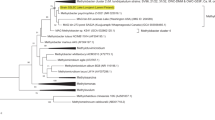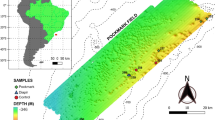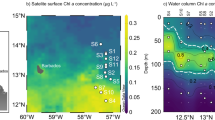Abstract
We investigated methanotrophic bacteria in slightly alkaline surface water (pH 7.4–8.7) of oilsands tailings ponds in Fort McMurray, Canada. These large lakes (up to 10 km2) contain water, silt, clay and residual hydrocarbons that are not recovered in oilsands mining. They are primarily anoxic and produce methane but have an aerobic surface layer. Aerobic methane oxidation was measured in the surface water at rates up to 152 nmol CH4 ml−1 water d−1. Microbial diversity was investigated via pyrotag sequencing of amplified 16S rRNA genes, as well as by analysis of methanotroph-specific pmoA genes using both pyrosequencing and microarray analysis. The predominantly detected methanotroph in surface waters at all sampling times was an uncultured species related to the gammaproteobacterial genus Methylocaldum, although a few other methanotrophs were also detected, including Methylomonas spp. Active species were identified via 13CH4 stable isotope probing (SIP) of DNA, combined with pyrotag sequencing and shotgun metagenomic sequencing of heavy 13C-DNA. The SIP-PCR results demonstrated that the Methylocaldum and Methylomonas spp. actively consumed methane in fresh tailings pond water. Metagenomic analysis of DNA from the heavy SIP fraction verified the PCR-based results and identified additional pmoA genes not detected via PCR. The metagenome indicated that the overall methylotrophic community possessed known pathways for formaldehyde oxidation, carbon fixation and detoxification of nitrogenous compounds but appeared to possess only particulate methane monooxygenase not soluble methane monooxygenase.
Similar content being viewed by others
Log in or create a free account to read this content
Gain free access to this article, as well as selected content from this journal and more on nature.com
or
Accession codes
References
Allen EW . (2008). Process water treatment in Canada’s oil sands industry: II. A review of emerging technologies. J Environ Eng Sci 7: 499–524.
Amaral JA, Knowles R . (1995). Growth of methanotrophs in methane and oxygen counter gradients. FEMS Microbiol Lett 126: 215–220.
Antony CP, Kumaresan D, Ferrando L, Boden R, Moussard H, Fernandez-Scavino A et al. (2010). Active methylotrophs in the sediments of Lonar Lake, a saline and alkaline ecosystem formed by meteor impact. ISME J 4: 1470–1480.
Barbier BA, Dziduch I, Liebner S, Ganzert L, Lantuit H, Pollard W et al. (2012). Methane-cycling communities in a permafrost-affected soil on Herschel Island, Western Canadian Arctic: active layer profiling of mcrA and pmoA genes. FEMS Microbiol Ecol 82: 287–302.
Bastviken D, Ejlertsson J, Tranvik L . (2002). Measurement of methane oxidation in lakes: a comparison of methods. Environ Sci Technol 36: 3354–3361.
Bussmann I, Rahalkar M, Schink B . (2006). Cultivation of methanotrophic bacteria in opposing gradients of methane and oxygen. FEMS Microbiol Ecol 56: 331–344.
Caporaso JG, Kuczynski J, Stombaugh J, Bittinger K, Bushman FD, Costello EK et al. (2010). QIIME allows analysis of high-throughput community sequencing data. Nat Methods 7: 335–336.
Carini S, Bano N, LeCleir G, Joye SB . (2005). Aerobic methane oxidation and methanotroph community composition during seasonal stratification in Mono Lake, California (USA). Environ Microbiol 7: 1127–1138.
Chistoserdova L, Kalyuzhnaya MG, Lidstrom ME . (2009). The expanding world of methylotrophic metabolism. Annu Rev Microbiol 63: 477–499.
Dalton H . (2005). The Leeuwenhoek lecture 2000. The natural and unnatural history of methane-oxidizing bacteria. Phil Trans Royal Soc B: Biol Sci 360: 1207–1222.
Dedysh SN, Derakshani M, Liesack W . (2001). Detection and enumeration of methanotrophs in acidic Sphagnum peat by 16S rRNA fluorescence in situ hybridization, including the use of newly developed oligonucleotide probes for Methylocella palustris. Appl Environ Microbiol 67: 4850–4857.
Dedysh SN, Dunfield PF, Derakshani M, Stubner S, Heyer J, Liesack W . (2003). Differential detection of type II methanotrophic bacteria in acidic peatlands using newly developed 16S rRNA-targeted fluorescent oligonucleotide probes. FEMS Microbiol Ecol 43: 299–308.
Dedysh SN, Dunfield PF . (2010). Facultative methanotrophs. In: Timmis KN (eds) Handbook of Hydrocarbon and Lipid Microbiology. Springer: Berlin, pp 1967–1976.
Dedysh SN . (2011). Cultivating uncultured bacteria from northern wetlands: knowledge gained and remaining gaps. Front Microbiol 2: 184.
DeSantis TZ, Hugenholtz P, Larsen N, Rojas M, Brodie EL, Keller K et al. (2006). Greengenes, a chimera-checked 16S rRNA gene database and workbench compatible with ARB. Appl Environ Microbiol 72: 5069–5072.
Dunfield PF . (2009). Methanotrophy in extreme environments. In: Battista J (eds) Encyclopedia of Life Sciences. John Wiley and Sons Ltd: Chichester.
Dunfield PF, Dedysh SN . (2010). Acidic environments. In: Timmis KN (ed.) Handbook of Hydrocarbon and Lipid Microbiology. Springer: Berlin, pp 2181–2192.
Energy Resources Conservation Board (2012) ST98-2011: Alberta’s Energy Reserves 2011 and Supply/Demand Outlook 2012-2021. http://www.ercb.ca/RSS/yp-starter/401.aspx.
Garrity GM, Bell JA, Lilburn T . (2001). Family I. Rhodocyclaceae fam. nov. In: Bergey DH, Boone DR, Garrity GM, Castenholz RW, Brenner DJ, Krieg NR, Staley JT (eds) Bergey’s Manual of Systematic Bacteriology: The Proteobacteria: Part C. The Alpha-, Beta-, Delta-, and Epsilonproteobacteria. Springer: Berlin, pp 887.
Government of Alberta (2012) Oil sands tailings factsheet http://www.oilsands.alberta.ca/FactSheets/Tailings_FSht_June_2012_Online.pdf.
Graef C, Hestnes AG, Svenning MM, Frenzel P . (2011). The active methanotrophic community in a wetland from the High Arctic. Environ Microbiol Rep 3: 466–472.
Han B, Chen Y, Abell G, Jiang H, Bodrossy L, Zhao J et al. (2009). Diversity and activity of methanotrophs in alkaline soil from a Chinese coal mine. FEMS Microbiol Ecol 70: 196–207.
He R, Wooller MJ, Pohlman JW, Quensen J, Tiedje JM, Leigh MB . (2012). Diversity of active aerobic methanotrophs along depth profiles of arctic and subarctic lake water column and sediments. ISME J 6: 1937–1948.
Henckel T, Friedrich M, Conrad R . (1999). Molecular analyses of the methane-oxidizing microbial community in rice field soil by targeting the genes of the 16S rRNA, particulate methane monooxygenase, and methanol dehydrogenase. Appl Environ Microbiol 65: 1980–1990.
Henckel T, Roslev P, Conrad R . (2000). Effects of O2 and CH4 on presence and activity of the indigenous methanotrophic community in rice field soil. Environ Microbiol 2: 666–679.
Hess M, Sczyrba A, Egan R, Kim TW, Chokhawala H, Schroth G et al. (2011). Metagenomic discovery of biomass-degrading genes and genomes from cow rumen. Science 331: 463–467.
Holowenko FM, MacKinnon MD, Fedorak PM . (2000). Methanogens and sulfate-reducing bacteria in oil sands fine tailings waste. Can J Microbiol 46: 927–937.
Horz HP, Raghubanshi AS, Heyer J, Kammann C, Conrad R, Dunfield PF . (2002). Activity and community structure of methane-oxidising bacteria in a wet meadow soil. FEMS Microbiol Ecol 41: 247–257.
Joseph SJ, Hugenholtz P, Sangwan P, Osborne CA, Janssen PH . (2003). Laboratory cultivation of widespread and previously uncultured soil bacteria. Appl Environ Microbiol 69: 7210–7215.
Kasperski KL, Mikula RJ . (2011). Waste streams of mined oil sands: characteristics and remediation. Elements 7: 387–392.
Kelly EN, Short JW, Schindler DW, Hodson PV, Ma M, Kwan AK et al. (2009). Oil sands development contributes polycyclic aromatic compounds to the Athabasca river and its tributaries. Proc Natl Acad Sci USA 106: 22346–22351.
Kelly EN, Schindler DW, Hodson PV, Short JW, Radmanovich R, Nielsen CC . (2010). Oil sands development contributes elements toxic at low concentrations to the Athabasca river and its tributaries. Proc Natl Acad Sci USA 107: 16178–16183.
Kip N, Dutilh BE, Pan Y, Bodrossy L, Neveling K, Kwint MP et al. (2011). Ultra-deep pyrosequencing of pmoA amplicons confirms the prevalence of Methylomonas and Methylocystis in Sphagnum mosses from a dutch peat bog. Environ Microbiol Rep 3: 667–673.
Kip N, Fritz C, Langelaan ES, Pan Y, Bodrossy L, Pancotto V et al. (2012). Methanotrophic activity and diversity in different Sphagnum magellanicum dominated habitats in the southernmost peat bogs of Patagonia. Biogeosciences 9: 47–55.
Kip N, Van Winden JF, Pan Y, Bodrossy L, Reichart GJ, Smolders AJP et al. (2010). Global prevalence of methane oxidation by symbiotic bacteria in peat-moss ecosystems. Nature Geosci 3: 617–621.
Knief C, Lipski A, Dunfield PF . (2003). Diversity and activity of methanotrophic bacteria in different upland soils. Appl Environ Microbiol 69: 6703–6714.
Kolb S, Knief C, Stubner S, Conrad R . (2003). Quantitative detection of methanotrophs in soil by novel pmoA-targeted real-time PCR assays. Appl Environ Microbiol 69: 2423–2429.
Kravchenko IK . (2002). Methane oxidation in boreal peat soils treated with various nitrogen compounds. Plant Soil 242: 157–162.
Krüger M, Treude T, Wolters H, Nauhaus K, Boetius A . (2005). Microbial methane turnover in different marine habitats. Paleogeog Palaeoclimatol Palaeoecol 227: 6–17.
Kunin V, Hugenholtz P . (2010). PyroTagger: a fast, accurate pipeline for analysis of rRNA amplicon pyrosequence data. The Open J 1: 1–8.
Lee S-Y, Lee SH, Jang JK, Cho K-S . (2011). Comparison of methanotrophic community and methane oxidation between rhizospheric and non-rhizospheric soils. Geomicrobiol J 28: 676–685.
Lin JL, Radajewski S, Eshinimaev BT, Trotsenko YA, McDonald IR, Murrell JC . (2004). Molecular diversity of methanotrophs in Transbaikal soda lake sediments and identification of potentially active populations by stable isotope probing. Environ Microbiol 6: 1049–1060.
Ludwig W, Strunk O, Westram R, Richter L, Meier H, Yadhukumar et al. (2004). ARB: a software environment for sequence data. Nucleic Acids Res 32: 1363–1371.
McDonald IR, Bodrossy L, Chen Y, Murrell JC . (2008). Molecular ecology techniques for the study of aerobic methanotrophs. Appl Environ Microbiol 74: 1305–1315.
Murase J, Frenzel P . (2008). Selective grazing of methanotrophs by protozoa in a rice field soil. FEMS Microbiol Ecol 65: 408–414.
Op den Camp HJM, Islam T, Stott MB, Harhangi HR, Hynes A, Schouten S et al. (2009). Minireview: environmental, genomic, and taxonomic perspectives on methanotrophic Verrucomicrobia. Environ Microbiol Rep 1: 293–306.
Penner TJ, Foght JM . (2010). Mature fine tailings from oil sands processing harbour diverse methanogenic communities. Can J Microbiol 56: 459–470.
Pester M, Friedrich MW, Schink B, Brune A . (2004). pmoA-based analysis of methanotrophs in a littoral lake sediment reveals a diverse and stable community in a dynamic environment. Appl Environ Microbiol 70: 3138–3142.
Prince RC, Gramain A, McGenity TJ . (2010). Prokaryotic hydrocarbon degraders. In: Timmis KN (eds) Handbook of Hydrocarbon and Lipid Microbiology. Springer: Berlin, pp 1669–1692.
Quagraine EK, Peterson HG, Headley JV . (2005). In situ bioremediation of naphthenic acids contaminated tailing pond waters in the Athabasca oil sands region--demonstrated field studies and plausible options: a review. J Environ Sci Health A Tox Hazard Subst Environ Eng 40: 685–722.
Ramos-Padrón E, Bordenave S, Lin S, Bhaskar IM, Dong X, Sensen CW et al. (2011). Carbon and sulfur cycling by microbial communities in a gypsum-treated oil sands tailings pond. Environ Sci Technol 45: 439–446.
Rooney RC, Bayley SE, Schindler DW . (2012). Oil sands mining and reclamation cause massive loss of peatland and stored carbon. Proc Natl Acad Sci USA 109: 4933–4937.
Semrau JD, DiSpirito AA, Yoon S . (2010). Methanotrophs and copper. FEMS Microbiol Rev 34: 496–531.
Semrau JD . (2011). Bioremediation via methanotrophy: overview of recent findings and suggestions for future research. Front Microbiol 2: 209.
Sharp CE, Stott MB, Dunfield PF . (2012). Detection of autotrophic verrucomicrobial methanotrophs in a geothermal environment using stable isotope probing. Front Microbiol 3: 303.
Solomon S, Qin D, Manning M, Chen Z, Marquis M, Avery KB et al. (2007) Contribution of Working Group I to the Fourth Assessment Report of the Intergovernmental Panel on Climate Change. Cambridge University Press: Cambridge, United Kingdom and New York, NY, USA.
Sommer DD, Delcher AL, Salzberg SL, Pop M . (2007). Minimus: a fast, lightweight genome assembler. BMC Bioinformatics 8: 64.
Stein LY, Klotz MG . (2011). Nitrifying and denitrifying pathways of methanotrophic bacteria. Biochem Soc Trans 39: 1826–1831.
Stoecker K, Bendinger B, Schöning B, Nielsen PH, Nielsen JL, Baranyi C et al. (2006). Cohn’s Crenothrix is a filamentous methane oxidizer with an unusual methane monooxygenase. Proc Natl Acad Sci USA 103: 2363–2367.
Stralis-Pavese N, Abell GC, Sessitsch A, Bodrossy L . (2011). Analysis of methanotroph community composition using a pmoA-based microbial diagnostic microarray. Nat Protoc 6: 609–624.
Surget-Groba Y, Montoya-Burgos JI . (2010). Optimization of de novo transcriptome assembly from next-generation sequencing data. Genome Res 20: 1432–1440.
Swart NC, Weaver AJ . (2012). The Alberta oil sands and climate. Nature Clim Change 2: 134–136.
Tavormina PL, Ussler W, Orphan VJ . (2008). Planktonic and sediment-associated aerobic methanotrophs in two seep systems along the North American margin. Appl Environ Microbiol 74: 3985–3995.
Tavormina PL, Orphan VJ, Kalyuzhnaya MG, Jetten MSM, Klotz MG . (2011). A novel family of functional operons encoding methane/ammonia monooxygenase-related proteins in gammaproteobacterial methanotrophs. Environ Microbiol Rep 3: 91–100.
Trotsenko YA, Khmelenina VN . (2002). Biology of extremophilic and extremotolerant methanotrophs. Arch Microbiol 177: 123–131.
van Bodegom P, Stams F, Mollema L, Boeke S, Leffelaar P . (2001). Methane oxidation and the competition for oxygen in the rice rhizosphere. Appl Environ Microbiol 67: 3586–3597.
Vorob’ev AV, Baani M, Doronina NV, Brady AL, Liesack W, Dunfield PF et al. (2011). Methyloferula stellata gen. nov., sp. nov., an acidophilic, obligately methanotrophic bacterium that possesses only a soluble methane monooxygenase. Int J Syst Evol Microbiol 61: 2456–2463.
Vuilleumier SP, Chistoserdova L, Lee MC, Bringel FO, Al Lajus, Zhou Y et al. (2009). Methylobacterium genome sequences: a reference blueprint to investigate microbial metabolism of C1 compounds from natural and industrial sources. Plos One 4: e5584.
Wagner D, Lipski A, Embacher A, Gattinger A . (2005). Methane fluxes in permafrost habitats of the Lena Delta: effects of microbial community structure and organic matter quality. Environ Microbiol 7: 1582–1592.
Ward N, Larsen O, Sakwa J, Bruseth L, Khouri H, Durkin AS et al. (2004). Genomic insights into methanotrophy: the complete genome sequence of Methylococcus capsulatus (Bath). PLoS Biol 2: e303.
Willems A, Gillis M . (2001). Family IV. Comamonadaceae. In: Bergey DH, Boone DR, Garrity GM, Castenholz RW, Brenner DJ, Krieg NR, Staley JT (eds) Bergey’s Manual of Systematic Bacteriology: The Proteobacteria: Part C. The Alpha-, Beta-, Delta-, and Epsilonproteobacteria. Springer: Berlin, pp 686–688.
Acknowledgements
We thank the mining companies for the support of this research. Particular thanks go to Samantha Tavener and Joe Fournier for providing samples. This research was supported by Genome Canada and Genome Alberta (Hydrocarbon Metagenomics) and the Institute for Sustainable Energy, Environment and Economy (ISEEE). CES was supported by doctoral fellowships from NSERC and Alberta Innovates-Technology Futures. ALB was supported by a postdoctoral award from NSERC. DNA Sequence data sets related to this project have been submitted to the Sequence Read Archive under accession number SRP013946.
Author information
Authors and Affiliations
Corresponding author
Additional information
Supplementary Information accompanies the paper on The ISME Journal website
Supplementary information
Rights and permissions
About this article
Cite this article
Saidi-Mehrabad, A., He, Z., Tamas, I. et al. Methanotrophic bacteria in oilsands tailings ponds of northern Alberta. ISME J 7, 908–921 (2013). https://doi.org/10.1038/ismej.2012.163
Received:
Revised:
Accepted:
Published:
Issue date:
DOI: https://doi.org/10.1038/ismej.2012.163
Keywords
This article is cited by
-
Novel copper-containing membrane monooxygenases (CuMMOs) encoded by alkane-utilizing Betaproteobacteria
The ISME Journal (2020)
-
A shared core microbiome in soda lakes separated by large distances
Nature Communications (2019)
-
DNA-SIP based genome-centric metagenomics identifies key long-chain fatty acid-degrading populations in anaerobic digesters with different feeding frequencies
The ISME Journal (2018)
-
Survey of methanotrophic diversity in various ecosystems by degenerate methane monooxygenase gene primers
AMB Express (2017)
-
Crenothrix are major methane consumers in stratified lakes
The ISME Journal (2017)



